Borage Plant (Borago Officinalis) Grow & Care Guide
Written by Iris
Oct 11 2021

Borage can be used as a common ornamental plant in gardens. Borage loves to grow and breed freely in the garden and on the roadside for many years. The dense flowers of Borage can produce excellent honey. It was originally reported from Aleppo in northern Syria, but it is now frequently found in most parts of Europe.
Although borage isn't ideal for growing in containers, if this is the only option, then choose a large pot (at least 25 cm deep and over 30 cm wide), filled two-thirds with peat-free, general-purpose potting compost and one third coarse grit.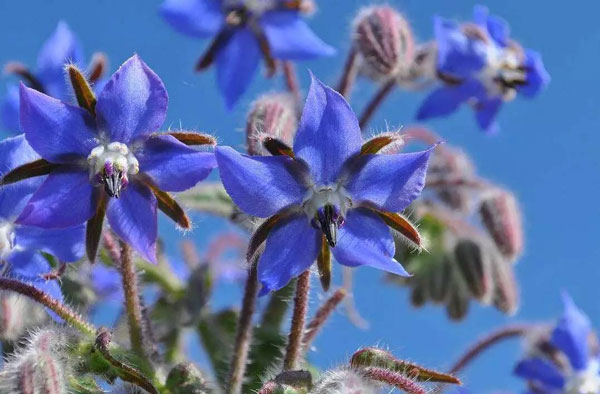
Borage plant will self-seed if the faded flowers are left on the plant. Depending on your garden, this may be desirable in an informal border, but if seeding is likely to be a nuisance, deadhead spent blooms before the seed develops.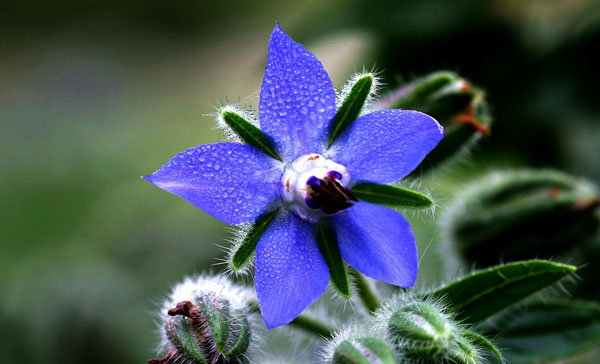
Before sowing, weed and rake over the soil. While Borage plants prefer rich well-drained soil they can grow in dry or poor soil. Whatever the condition of the soil working in organic matter such as homemade compost will help the borage.
Sow seeds as thinly as possible on the surface of the well drained soil. Cover with a thin layer of well drained soil and gently water.
Following germination, once the seedlings are about 3 inches tall thin them out. Ideally the borage should be spaced 12 inches apart.
While borage seeds are best sown directly into their growing position they can also be started undercover for an early harvest in your herb garden. Sow up to four weeks before your last predicted frost date in biodegradable pots.
Borage produces a long taproot that shouldn't be disturbed when transplanting. Growing the seedlings in biodegradable pots means that you can plant the seedling still in the container in its final position. As the plant grows the pot will break down into the soil.
Allow the seeds to grow on in containers. Once the last local frost date has passed, harden the young plants off before transplanting into their final position in your herb garden.
Borage's self-seeding habit means that it will spread throughout an herb garden if left unchecked. While the borage are easy to remove, growing in containers is an easy way to keep their growth habit in check.
If you are sowing in containers make sure there are drainage holes in the bottom of your chosen vessel. Fill the container with fresh, good quality soil.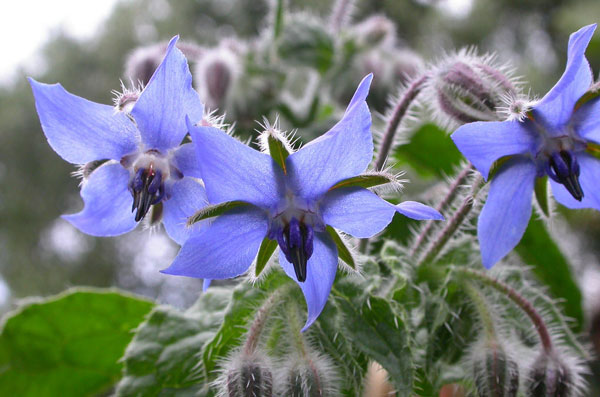
Prune away flowers as they fade. This prevents the borage plant from producing seeds. If you want to grow bee bush again the following year allow the flowers to seed. The seeds can then be harvested when the pods ripen and turn brown. If the seed heads aren’t removed they will split and the plant will re-seed in the same position the following year.
Allowing the plant to re-seed can also cause it to spread through a space. Unwanted plants are easily pulled up.
The fungal infections most likely to infect plants when conditions are too wet include: leaf spot, powdery mildew, root rot, and stem rot. To avoid leaf spot and powdery mildew, be sure to space plants the recommended nine to 18 inches apart, depending upon their expected mature widths. This helps maintain sufficient air circulation and inhibits the buildup of excess moisture and humidity.
Root and stem rot begin in oversaturated soil. Avoidance measures include sowing in soil that drains well, and not overwatering. In the event of a fungal outbreak, remove affected foliage or entire plants and discard them in the trash.You may also apply a food-safe fungicide according to package instructions.
It's unlikely that your plants will be bothered by deer or rabbits, as the aromatic leaves and fuzzy texture don't seem to appeal to them.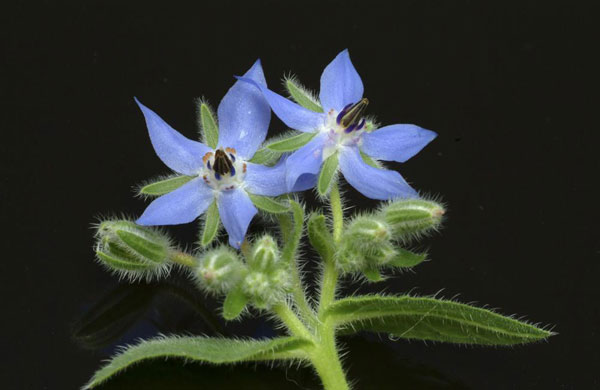
Borago officinalis ‘Variegata’ has white mottling on the green leaves. Flowers are less intense than common borage.
Borago officinalis ‘Alba’, also called white borage, blooms later in the season than blue varieties, with lovely white flowers. "Alba" is a sturdier plant than common borage.
Creeping borage (Borago pygmaea) is a sprawling species with pale blue flowers that bloom from late spring to late fall. creeping borage is a short-lived perennial species.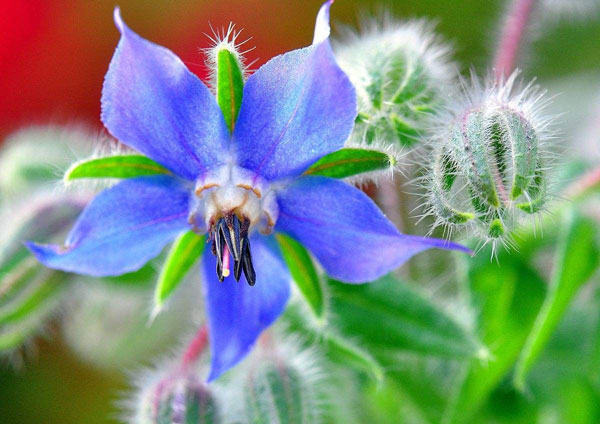
Where to Grow Borage PlantWhen to Grow Borage PlantHow to Grow Borage PlantHow to Care for Borage PlantBorage Lighting RequirementsBorage Soil CareBorage WateringBorage Temperature & Humidity CareBorage Fertilizer CareBorage PruningBorage Pests & DiseasesBorage VarietiesBorage Plant Care FAQAre borage leaves safe to eat?Does borage come back every year?Is borage good for the garden?Is borage poisonous to dogs?
Where to Grow Borage Plant
Sow the large black borage seeds directly where the plant is to flower, as it forms a deep root and doesn't do well if transplanted. Choose a well-drained site that gets sun for at least half the day. If your ground is heavy and slow to drain, add fine gravel and mound up the soil, so water drains away more easily. Borage plant does best in soil low in fertility so there's no need to add fertilizer or organic matter.Although borage isn't ideal for growing in containers, if this is the only option, then choose a large pot (at least 25 cm deep and over 30 cm wide), filled two-thirds with peat-free, general-purpose potting compost and one third coarse grit.

When to Grow Borage Plant
Sow borage seed from mid spring, after the last frosts. A second sowing can be made in late spring. It's best to sow borage seed where you want it to grow, as it doesn't do well when transplanted.Borage plant will self-seed if the faded flowers are left on the plant. Depending on your garden, this may be desirable in an informal border, but if seeding is likely to be a nuisance, deadhead spent blooms before the seed develops.

How to Grow Borage Plant
Borage is a fast growing plant. In the right conditions you can harvest the borage within 6 to 8 weeks of sowing. Begin sowing Borage seeds from early April onwards.Before sowing, weed and rake over the soil. While Borage plants prefer rich well-drained soil they can grow in dry or poor soil. Whatever the condition of the soil working in organic matter such as homemade compost will help the borage.
Sow seeds as thinly as possible on the surface of the well drained soil. Cover with a thin layer of well drained soil and gently water.
Following germination, once the seedlings are about 3 inches tall thin them out. Ideally the borage should be spaced 12 inches apart.
While borage seeds are best sown directly into their growing position they can also be started undercover for an early harvest in your herb garden. Sow up to four weeks before your last predicted frost date in biodegradable pots.
Borage produces a long taproot that shouldn't be disturbed when transplanting. Growing the seedlings in biodegradable pots means that you can plant the seedling still in the container in its final position. As the plant grows the pot will break down into the soil.
Allow the seeds to grow on in containers. Once the last local frost date has passed, harden the young plants off before transplanting into their final position in your herb garden.
Borage's self-seeding habit means that it will spread throughout an herb garden if left unchecked. While the borage are easy to remove, growing in containers is an easy way to keep their growth habit in check.
If you are sowing in containers make sure there are drainage holes in the bottom of your chosen vessel. Fill the container with fresh, good quality soil.

How to Care for Borage Plant
Borage Lighting Requirements
A common question when planting and growing borage is, how much light does borage need? Plant your borage plants and seeds in full sun or partial shade. Plants will bloom more vigorously if they are planted in an area where they receive 6-8 hours of direct sunlight daily.Borage Soil Care
Borage soil should be well-tilled and well-draining. Borage plant is a vibrant herbaceous plant that can tolerate soil that falls between 4.5-8.5 on the pH scale but thrives optimally in the middle at a pH of 6.5.Borage Watering
It can tricky to figure out exactly how often you should water borage plants. The answer is simple, water borage plants regularly. They are not drought tolerant and need plenty of water to thrive. However, try and avoid over-soaking them.Borage Temperature & Humidity Care
Suitable to grow in USDA zones 3 -10, borage is tolerant of high and cool temperatures but will die back with the onset of frost.Provide lots of space between plants to improve air circulation and to reduce the risk of powdery mildew when humidity is high.Borage Fertilizer Care
Borage growing in poor soil will benefit from fertilization. Applying a fertilizer high in phosphorus helps to prolong the plants flowering period. Alternatively apply a homemade compost tea or diluted fish emulsion. Either of these will also help to extend the flowering period of the borage.Borage Pruning
Prune or pinch out new growth once the borage reaches 6 inches in height. This encourages branching and helps to keep the plants more compact and robust. Pruning back to half the plants size in midsummer encourages the plant to produce fresh, tender leaves for a late harvest.Prune away flowers as they fade. This prevents the borage plant from producing seeds. If you want to grow bee bush again the following year allow the flowers to seed. The seeds can then be harvested when the pods ripen and turn brown. If the seed heads aren’t removed they will split and the plant will re-seed in the same position the following year.
Allowing the plant to re-seed can also cause it to spread through a space. Unwanted plants are easily pulled up.
Borage Pests & Diseases
Borage Officinalis is not prone to problems with insects or disease. It is valued in the garden because it attracts beneficial insects that feed on many pests, making it a great companion plant. However, if its growing environment is less than ideal, trouble may arise.The fungal infections most likely to infect plants when conditions are too wet include: leaf spot, powdery mildew, root rot, and stem rot. To avoid leaf spot and powdery mildew, be sure to space plants the recommended nine to 18 inches apart, depending upon their expected mature widths. This helps maintain sufficient air circulation and inhibits the buildup of excess moisture and humidity.
Root and stem rot begin in oversaturated soil. Avoidance measures include sowing in soil that drains well, and not overwatering. In the event of a fungal outbreak, remove affected foliage or entire plants and discard them in the trash.You may also apply a food-safe fungicide according to package instructions.
It's unlikely that your plants will be bothered by deer or rabbits, as the aromatic leaves and fuzzy texture don't seem to appeal to them.

Borage Varieties
Most gardeners plant the pure species plant, Borago officinalis. However, there are two common cultivars, as well as a closely related species:Borago officinalis ‘Variegata’ has white mottling on the green leaves. Flowers are less intense than common borage.
Borago officinalis ‘Alba’, also called white borage, blooms later in the season than blue varieties, with lovely white flowers. "Alba" is a sturdier plant than common borage.
Creeping borage (Borago pygmaea) is a sprawling species with pale blue flowers that bloom from late spring to late fall. creeping borage is a short-lived perennial species.

Borage Plant Care FAQ
Are borage leaves safe to eat?
Its leaves, flowers and stalks are edible and taste a little like cucumber. Borage leaves are good in salads, yoghurt or cream cheese mixtures, or served with shellfish.Does borage come back every year?
Borage is an annual, which means it completes its life cycle within one growing season. It grows readily from seed which can be sown directly in the ground – no special equipment required.Is borage good for the garden?
In the garden, the uses of borage include repelling pests such as hornworms, attracting pollinators, and aiding any plants it is interplanted with by increasing resistance to pests and disease. It is also helpful to, and compatible with, most plants — notably tomatoes, strawberries and squash.Is borage poisonous to dogs?
Borage is an amazingly versatile herb. It's wonderful in summer salads and drinks, and its oils are great for your dog's skin, which is why we love it at Lintbells (more about that later).Latest Updated
- Benefits of Bugleweed - 7 Science-backed Health Benefits
- Bugleweed Dangers & Side Effects - Is It Poisonous?
- How to Plant Evergreen Trees - What You Should Know
- When to Plant Evergreens - Grow Guide for Evergreen Trees
- 12 Wonderful Evergreen Shrubs for Your Garden
- 12 Popular Evergreen Plants with Pictures for Beginners
- When And How To Prune A Lilac Bush Like a Pro
- How to Grow & Care for Lilac Vine (Hardenbergia Violacea)
- Japanese Lilac Tree (Syringa Reticulata) Care & Propagation Guide
- Shumard Oak Pros and Cons - What to Know
Popular Articles
- Winter maintenance of Antirrhinum Majus
- How to Grow Terminalia Mantaly Tree
- How to Grow and Care for Crossostephium Chinense
- How to grow Antirrhinum Majus in spring
- Peristeria Elata (Dove Orchid) Profile: Info & Care Guide
- Underwatered Snake Plant (Sansevieria Trifasciata) - Signs And How To Fix
- How to Care for Brazilian Jasmine Plant (Mandevilla Sanderi)
- How to Grow & Care for Graptopetalum Purple Delight in Summer
- Rosa Chinensis (China Rose): Plant Growing & Care Tips
- How to Care for Baby Sun Rose (Aptenia Cordifolia)